Honolulu International Airport
| Honolulu International Airport Kahua Mokulele Kauʻāina o Honolulu | |||||||||||||||||||||||||||||||
|---|---|---|---|---|---|---|---|---|---|---|---|---|---|---|---|---|---|---|---|---|---|---|---|---|---|---|---|---|---|---|---|
 | |||||||||||||||||||||||||||||||
|
IATA: HNL – ICAO: PHNL – FAA LID: HNL – WMO: 91182 | |||||||||||||||||||||||||||||||
| Summary | |||||||||||||||||||||||||||||||
| Airport type | Public / Military | ||||||||||||||||||||||||||||||
| Owner | State of Hawaii | ||||||||||||||||||||||||||||||
| Operator | Department of Transportation | ||||||||||||||||||||||||||||||
| Serves | Honolulu, Island of O'ahu | ||||||||||||||||||||||||||||||
| Location | Honolulu, Hawaii, United States | ||||||||||||||||||||||||||||||
| Hub for | |||||||||||||||||||||||||||||||
| Elevation AMSL | 13 ft / 4 m | ||||||||||||||||||||||||||||||
| Coordinates | 21°19′07″N 157°55′21″W / 21.31861°N 157.92250°WCoordinates: 21°19′07″N 157°55′21″W / 21.31861°N 157.92250°W | ||||||||||||||||||||||||||||||
| Website | hawaii.gov/hnl | ||||||||||||||||||||||||||||||
| Maps | |||||||||||||||||||||||||||||||
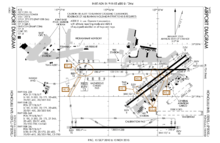 FAA airport diagram | |||||||||||||||||||||||||||||||
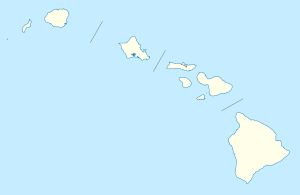 HNL Location of airport in Hawaii | |||||||||||||||||||||||||||||||
| Runways | |||||||||||||||||||||||||||||||
| |||||||||||||||||||||||||||||||
| Statistics (2012) | |||||||||||||||||||||||||||||||
| |||||||||||||||||||||||||||||||
Honolulu International Airport (IATA: HNL, ICAO: PHNL, FAA LID: HNL) is the principal aviation gateway of the City & County of Honolulu on Oahu in the State of Hawaii. It is identified as one of the busiest airports in the United States, with traffic now exceeding 21 million passengers a year and rising.[2]
It is located in the Honolulu census-designated place three miles (5 km) northwest of Honolulu's central business district.[3][4] Main roads leading to the airport are Nimitz Highway and the Queen Liliuokalani Freeway of Interstate H-1.
Honolulu International Airport serves as the principal hub of Hawaiian Airlines, the largest Hawaii-based airline. Hawaiian Airlines offers flights between the various airports of the Hawaiian Islands and also serves the continental United States, Australia, New Zealand, American Samoa, Tahiti, Japan, China, and South Korea. It is host to major United States and international airlines, with direct flights to North American, Asian, and Pacific Rim destinations. In addition to services to most major western cities and many smaller gateways, especially in California, the airport has succeeded in attracting long-haul services to the East Coast including the recently added destinations of Toronto-Pearson and Washington-Dulles, which have joined established services to Atlanta, New York-JFK and Newark.
It is also the base for Aloha Air Cargo, which previously offered both passenger and cargo services under the name Aloha Airlines. This airline ceased passenger flights on March 31, 2008 and sold off its cargo services to Seattle-based Saltchuk Resources, Inc (also owners of inter-island sea-based shipping company Young Brothers and Hawaiian Tug & Barge.)
In 2012, the airport handled 19,291,412 passengers, 278,145 aircraft movements and processed 412,270 metric tonnes of cargo.[1]
History
HNL opened in March 1927 as John Rodgers Airport, named after World War I naval officer John Rodgers.[5] It was funded by the territorial legislature and the Chamber of Commerce, and was the first full airport in Hawaii: aircraft had previously been limited to small landing strips, fields or seaplane docks. From 1939 to 1943, the adjacent Keehi Lagoon was dredged for use by seaplanes, and the dredged soil was moved to HNL to provide more space for conventional airplanes.
The U.S. military grounded all civil aircraft and took over all civil airports after the attack on Pearl Harbor, and Rodgers Field was designated Naval Air Station Honolulu. The Navy built a control tower and terminal building, and some commercial traffic was allowed during daylight hours. Rodgers Field was returned to the Territory of Hawaii in 1946. At the time, at 4,019 acres (16.26 km2), it was one of the largest airports in the United States, with four paved land runways and three seaplane runways.[5]
John Rodgers Airport was renamed Honolulu Airport in 1947; "International" was added to the name in 1951.[5] Being near the center of the Pacific Ocean it was a stop for many transpacific flights. By 1950 it was the third-busiest airport in the United States in terms of aircraft operations, and its 13,097-foot (3,992 m) runway was the longest in the world in 1953.[5] In summer 1959 Qantas began the first jet service to Honolulu on its flights between Australia and California.[6] Aeronautical engineer and airline consultant, Frank Der Yuen, advised in the design of the original building and founded its aerospace museum.[7]
The original terminal building on the southeast side of runways 4 was replaced by the John Rodgers Terminal, which was dedicated on August 22, 1962 and opened on October 14, 1962.[5] From 1970 through 1978, the architect Vladimir Ossipoff designed a terminal modernization project that remodeled this terminal and created several additions,[8][9] which included the Diamond Head Concourse in 1970, the Ewa Concourse in 1972, and the Central Concourse in 1980.[10]
Pan Am used Honolulu as a transpacific hub for many years, initially as a connecting point between the West Coast and Polynesia (Fiji, New Caledonia and New Zealand) in 1946,[11] followed by service to East Asia through Midway Island and Wake Island from 1947.[12] By the mid-1970s Pan Am offered nonstop service from Honolulu to Japan, Guam, Australia, New Zealand and Fiji, as well as to cities on the West Coast.[13] Continental Airlines used Honolulu as a stopover point for charter service to Southeast Asia during the Vietnam War era, and to feed its Guam-based Air Micronesia operation.[14] American Airlines also operated flights to Australia and the South Pacific through Honolulu from 1970 to 1975.[15] Many foreign carriers used Honolulu as a transpacific stopover point, including Air New Zealand, China Airlines, Japan Airlines, Korean Air, Philippine Airlines, Qantas and Singapore Airlines.[16]
Modernization and history since 2006
On March 24, 2006 Hawaii Governor Linda Lingle unveiled a $2.3 billion modernization program for Hawaii airports over a 12-year period, with $1.7 billion budgeted for Honolulu International Airport.[17] The plan involves implementing short-term projects within the first five years to improve passenger service and increase security and operational efficiencies.[18]
As part of the modernization, flight display monitors throughout the airport have been upgraded, new food and beverage vendors have been added, and a new parking garage across from the International Arrivals terminal has been completed. Current projects include an international arrivals corridor with moving sidewalks built atop the breezeway leading to the Ewa Concourse. The first phase of the project was completed in October 2009, while the remainder of the two phase project was completed in 2010.[19]
In 2011, Hawaiian Airlines renovated the check-in lobby of the Interisland Terminal, replacing the traditional check-in counters with six circular check-in islands in the middle of the lobbies, which can be used for inter-island, mainland, and international flights. This renovation project was fully funded by Hawaiian Airlines and not a part of the modernization program.[20]
Future projects include construction of a Mauka Concourse branching off the Interisland Terminal, the first concourse expansion at Honolulu International Airport in 15 years. Construction of the concourse will involve replacing the existing Commuter Terminal.[21] This new concourse will be for the exclusive use of Hawaiian Airlines, and will allow it to reduce use of overseas terminal gates for international and US mainland flights. This will mean less walking for passengers who check in, clear security, and use the baggage claim at the inter-island terminal. It will also free up gates in the overseas terminal for use by other airlines. Landside plans include construction of a consolidated rental car facility (CONRAC). A temporary rental car center is currently being built in the overseas parking garage so that the existing rental car facilities can be demolished to make way for the new permanent facility.
By 2012, Hawaiian Airlines was re-establishing Honolulu International Airport as a connecting hub between the United States mainland and the Asia-Pacific region.[22] That year, according to a Massachusetts Institute of Technology study, the airport had 24% fewer domestic departure flights than it did in 2007.[23]
Authority
Honolulu International Airport is part of a centralized state structure governing all of the airports and seaports of Hawaiʻi. The official authority of Honolulu International Airport is the Governor of Hawaiʻi, who appoints the Director of the Hawaiʻi State Department of Transportation who has jurisdiction over the Hawaiʻi Airports Administrator.
The Hawaiʻi Airports Administrator oversees six governing bodies: Airports Operations Office, Airports Planning Office, Engineering Branch, Information Technology Office, Staff Services Office, Visitor Information Program Office. Collectively, the six bodies have authority over the four airport districts in Hawaiʻi: Hawaiʻi District, Kauaʻi District, Maui District and the principal Oʻahu District. Honolulu International Airport is a subordinate of the Oʻahu District officials.
Facilities and aircraft
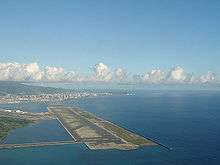
The airport has four major runways, which it operates in conjunction with the adjacent Hickam Air Force Base.[24] The principal runway designated 8R/26L, also known as the Reef Runway, was the world's first major runway constructed entirely offshore. Completed in 1977, the Reef Runway was a designated alternate landing site for the Space Shuttle.
In addition to the four paved runways, Honolulu International Airport has two designated offshore runways designated 8W/26W and 4W/22W for use by seaplanes.
The entire terminal complex features twenty-four-hour medical services, restaurants, shopping centers and a business center with conference rooms for private use. Passengers have the option of using various short-term and long-term parking structures on the grounds of Honolulu International Airport.
For the 12-month period ending January 30, 2014, the airport had 286,897 aircraft operations, an average of 786 per day. Of these movements 53% were scheduled commercial, 25% air taxi, 16% general aviation and 5% military. There are 217 aircraft based at this airport: 51% single-engine, 21% multi-engine, 15% military, 9% helicopter and 3% jet.[25]
All Nippon Airways has its Honolulu Office in Airport Building 47.[26] When Mid-Pacific Airlines was in operations, its headquarters were on the airport property.[27]
Terminals
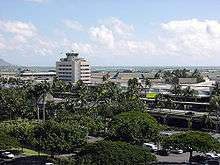
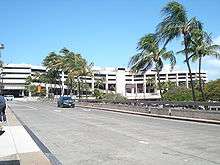
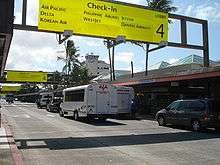
Honolulu International Airport has three main terminal buildings. A fleet of Chance RT-52 buses provide inter-terminal transportation between the ticket counters of all three terminals and between the concourses in the Inter-island and Main terminals. These buses, known as "Wiki Wiki" buses (from the Hawaiian word for "quick"), are the namesake for the WikiWikiWeb, the first wiki. All gates in the airport are connected post-security. However, passengers with carry-on luggage who arrive in the inter-island or commuter terminal and wish to connect to a flight in the overseas terminal must clear an agricultural inspection.
Overseas Terminal (Gates 6–34)
The Overseas Terminal serves U.S domestic and international destinations. All luggage departing Hawaii for the US mainland, Guam, or international destinations must clear agricultural inspection. Bags to be checked must be scanned at dedicated agriculture inspection stations near the terminal entrance before checking in. Agricultural inspection for carry-on luggage, however, is carried out at the overseas TSA checkpoints. All boarding gates in the Main Overseas Terminal at Honolulu International are common use, shared among all airlines, and may change daily as the need arises. No gates are assigned to any specific airline. The Main Overseas Terminal is divided into three concourses:
- Diamond Head Concourse contains gates 6–11
- Central Concourse contains gates 14–23
- Ewa Concourse contains gates 26–34
- Gates 12-13 and 24-25 are part of the main terminal building
Inter-island Terminal (Gates 49–61)
The Inter-island Terminal mainly serves the inter-island and some US mainland flights and departing international flights of Hawaiian Airlines; most of Hawaiian's U.S. Mainland and International departures leave from gates in the overseas terminal. It is designed to handle flights of jet aircraft between the major commercial airports in the Hawaiian Islands. The former Aloha Airlines and Mokulele Airlines Alii Lounge has been converted to a second Hawaiian Airlines Premier Club Lounge near Gate 56.
On the ground level, Hawaiian Airlines uses Baggage Claim B for U.S. Mainland arrivals, and Baggage Claim C is used for inter-island and U.S. Mainland arrivals. International arrivals on Hawaiian Airlines use the International Arrivals Baggage Claim located in the Main Terminal. Mokulele Airlines and Aloha Airlines formerly occupied Baggage Claim C.
- Makai Pier contains gates 49-53
- Gates 54-61 are part of the main terminal building
Commuter Terminal (Gates 62–80)
The Commuter Terminal serves smaller airlines which operate flights between both the smaller and major commercial airports in the island chain.
Boarding and deplaning is conducted directly on the tarmac, using an auxiliary incline ramp to avoid the air-stairs. Passengers who depart from the commuter terminal bound for another island, and are connecting to a flight bound for the U.S. mainland may not have baggage checked through to their final destination. The bags must be claimed at the next airport and be re-checked after completing pre-departure agriculture inspection formalities.
The commuter terminal is slated for closure and demolition in order to make way for an expansion of the inter-island terminal. Originally, a replacement commuter terminal was planned to be built on the Diamond Head side of the airport. However, since those plans, two of the four airlines occupying the commuter terminal exited the market, and another significantly cut back their service. This reduction in commuter airline service as well as higher than expected project cost led to the cancellation of the project. The state is still figuring out how to accommodate the two remaining commuter airlines once this terminal is demolished.
Airlines and destinations
Passenger
Cargo
Fixed-base operators
A number of fixed-base operators are located along Lagoon Drive on the airport's southeastern perimeter. While these focus on general aviation services, there are a few small passenger airline operations that operate from these facilities, rather than from the main terminal complex. Air tour flights typically depart from this area as well.
| Airlines | Destinations | FBO |
|---|---|---|
| Makani Kai Air Charters | Kalaupapa, Molokai | Makani Kai |
| Te Mauri Travel operated by Maritime Air Charters | Kiritimati | Castle & Cooke Aviation |
Traffic and statistics
The largest airline at Honolulu airport is Hawaiian Airlines offering 13,365 seats per day, which represents a 45% market share. The No. 2 and No. 3 carriers are United and Japan Airlines (JAL) with 7.7% and 7.4% market share respectively.
Traffic between Honolulu and the mainland United States is dominated by flights to and from Los Angeles and San Francisco. These two cities, plus Seattle, account for around half of all flights between the mainland and Honolulu. Hawaiian Airlines, with 11 routes, has the highest market share on routes between Honolulu and the continental United States.[28][29]
Internationally, Japan is the dominant market. Two-thirds of international seats head for Nagoya, Osaka, and Tokyo (both Haneda and Narita airports) with services provided by Japan Airlines, Air Japan, China Airlines, Delta, Hawaiian, or United. Narita alone is served with 61 weekly departures and is the second busiest international route from the United States, trailing only the lucrative John F. Kennedy Airport-London Heathrow route.[28][30]
Other major international routes are to Seoul (25 weekly departures operated by Korean Airlines, Asiana Airlines and Hawaiian), Sydney (12 weekly departures operated by Hawaiian, Jetstar and Qantas) and Vancouver (19 weekly departures split between Air Canada and Westjet).
In October 2009, China-based Hainan Airlines was granted approval for a nonstop flight from Honolulu to Beijing.[31] It would be the first mainland Chinese carrier to serve Hawaii and the airline's second US destination after Seattle. The airline originally planned to launch the service by the summer of 2010,[32] but the route has been further delayed due to visa concerns and landing fees.[33] China Eastern, however, announced that it will begin nonstop flights from Honolulu to Shanghai on August 9, 2011 instead, marking the first ever direct, regularly scheduled service between China and Hawaii.[34] On January 21, 2014, Air China launched the second China-Hawaii route with nonstop flights from Honolulu to Beijing, also the first nonstop route between the 2 cities.[35]
Las Vegas based Allegiant Air used to offer once-weekly non-stop service to many smaller markets in the mainland Western United States. These cities included Bellingham, Boise, Eugene, Fresno, Spokane, and Stockton. Allegiant still offers service to Las Vegas and Los Angeles.[36] It was announced that Allegiant plans to drop service to Honolulu altogether in August 2016.[37]
Top destinations
| Rank | City | Passengers | Carriers |
|---|---|---|---|
| 1 | Los Angeles, California | 1,071,000 | Allegiant, American, Delta, Hawaiian, United, Virgin America |
| 2 | Kahului, Hawaii | 991,000 | Hawaiian, Island, Mokulele |
| 3 | Lihue, Hawaii | 680,000 | Hawaiian, Island |
| 4 | Kailua–Kona, Hawaii | 675,000 | Hawaiian |
| 5 | Hilo, Hawaii | 540,000 | Hawaiian |
| 6 | San Francisco, California | 479,000 | Delta, Hawaiian, United, Virgin America |
| 7 | Seattle/Tacoma, Washington | 344,000 | Alaska, Delta, Hawaiian |
| 8 | Las Vegas, Nevada | 264,000 | Allegiant, Hawaiian, Omni Air International |
| 9 | Phoenix–Sky Harbor, Arizona | 217,000 | American, Hawaiian, US Airways |
| 10 | Portland, Oregon | 164,000 | Alaska, Delta, Hawaiian |
| Rank | City | Passengers | Carriers |
|---|---|---|---|
| 1 | Tokyo (Narita), Japan | 1,499,299 | ANA, China Airlines, Delta, JAL, Hawaiian, United |
| 2 | Osaka (Kansai), Japan | 559,752 | Delta, Hawaiian, JAL |
| 3 | Tokyo (Haneda), Japan | 526,264 | ANA, Hawaiian, JAL |
| 4 | Seoul (Incheon), South Korea | 493,400 | Asiana, Hawaiian, Korean |
| 5 | Sydney, Australia | 405,637 | Hawaiian, Jetstar, Qantas |
| 6 | Nagoya (Centrair), Japan | 297,701 | Delta, JAL |
| 7 | Vancouver, Canada | 241,659 | Air Canada, WestJet |
| 8 | Fukuoka, Japan | 178,100 | Delta |
| 9 | Auckland, New Zealand | 134,410 | Air New Zealand, Hawaiian |
| 10 | Shanghai (Pudong), China | 95,341 | China Eastern |
Airline market share
| Rank | Airline | Passengers | Share |
|---|---|---|---|
| 1 | Hawaiian Airlines | 8,098,000 | 57.84% |
| 2 | United Airlines | 2,201,000 | 15.72% |
| 3 | Delta Air Lines | 1,242,000 | 8.87% |
| 4 | American Airlines | 930,000 | 6.64% |
| 5 | Alaska Airlines | 764,000 | 5.46% |
Annual traffic
| Year | Passengers | Year | Passengers | Year | Passengers | Year | Passengers | Year | Passengers | Year | Passengers | Year | Passengers | Year | Passengers | Year | Passengers |
|---|---|---|---|---|---|---|---|---|---|---|---|---|---|---|---|---|---|
| 2010 | 18,443,873 | 2000 | 23,027,674 | 1990 | 23,367,770 | 1980 | 15,155,337 | 1970 | 7,234,594 | 1960 | 1,609,303 | 1950 | 516,961 | 1940 | 28,624 | ||
| 2009 | 18,171,937 | 1999 | 22,560,399 | 1989 | 22,617,340 | 1979 | 15,506,169 | 1969 | 5,538,271 | 1959 | 1,069,523 | 1949 | 467,397 | 1939 | 21,861 | ||
| 2008 | 18,809,103 | 1998 | 22,636,354 | 1988 | 21,577,541 | 1978 | 14,703,764 | 1968 | 4,632,216 | 1958 | 981,022 | 1948 | 469,849 | 1938 | 28,611 | ||
| 2007 | 21,517,476 | 1997 | 23,880,346 | 1987 | 20,380,042 | 1977 | 12,922,895 | 1967 | 4,363,672 | 1957 | 950,883 | 1947 | 471,944 | ||||
| 2006 | 20,266,686 | 1996 | 24,326,737 | 1986 | 19,076,395 | 1976 | 12,182,519 | 1966 | 3,534,450 | 1956 | 881,814 | 1946 | 272,513 | ||||
| 2015 | 20,000,000 | 2005 | 20,179,634 | 1995 | 23,672,894 | 1985 | 17,497,204 | 1975 | 11,306,443 | 1965 | 3,019,789 | 1955 | 775,441 | 1945 | 170,437 | ||
| 2014 | 19,972,910 | 2004 | 19,334,674 | 1994 | 22,995,976 | 1984 | 17,287,620 | 1974 | 10,639,503 | 1964 | 2,556,330 | 1954 | 720,033 | 1944 | 110,242 | ||
| 2013 | 19,776,751 | 2003 | 18,690,888 | 1993 | 22,061,953 | 1983 | 16,035,463 | 1973 | 10,109,483 | 1963 | 2,225,568 | 1953 | 684,559 | 1943 | 107,945 | ||
| 2012 | 19,291,412 | 2002 | 19,749,902 | 1992 | 22,608,188 | 1982 | 16,493,587 | 1972 | 8,704,003 | 1962 | 1,911,060 | 1952 | 661,189 | 1942 | 82,397 | ||
| 2011 | 17,991,497 | 2001 | 20,151,935 | 1991 | 22,224,594 | 1981 | 15,376,489 | 1971 | 7,604,992 | 1961 | 1,723,979 | 1951 | 582,281 | 1941 | 37,099 | 1931 | 12,206 |
Public transport
TheBus routes 19, 20, and 31 stop on the upper (departure) level of the airport. Routes 19 and 20 connect the airport to Pearlridge Center (20 only), Hickam AFB (19 only), Downtown Honolulu, Ala Moana Center, and Waikiki. Route 31 connects the airport to Tripler Army Medical Center, via Kalihi Transit Center. Routes 9, 40, 40A, 42, and 62 run on Nimitz Highway within walking distance of the airport.
When Honolulu Rail Transit phase II opens in 2019, there will be a station at the airport connecting it to Downtown Honolulu and points west of the airport.[44]
Accidents and incidents
- On March 22, 1955, a United States Navy Douglas R6D-1 Liftmaster transport on descent to a landing in darkness and heavy rain strayed off course and crashed into Pali Kea Peak in the southern part of Oahu's Waianae Range, killing all 66 people on board. It remains the worst air disaster in Hawaii's history and the deadliest heavier-than-air accident in the history of U.S. naval aviation.[45][46][47][48]
- On July 22, 1962, Canadian Pacific Air Lines Flight 301, a Bristol Britannia 314 crashed while it attempted a "go-around". 27 of the 40 passengers and crew on board were killed.
- Vickers Viscount N7410 of Aloha Airlines was damaged beyond repair when it collided on the ground with Douglas DC-9-31 N906H of Hawaiian Airlines on June 27, 1969.[49]
- On August 8, 1971, Vickers Viscount N7415 of Aloha Airlines was damaged beyond economic repair when a fire broke out upon landing.[50]
- Pan Am Flight 830: a bomb exploded aboard as the aircraft prepared for approach to Honolulu from Tokyo on August 11, 1982. One teenager was killed and 15 others were injured. The aircraft did not disintegrate, and made a safe emergency landing in Honolulu.
- Aloha Airlines Flight 243: flying from Hilo to Honolulu International Airport on April 28, 1988, experienced a rapid decompression. An 18-foot-long (5.5 m) section of the fuselage roof and sides were torn from the airplane, due to metal fatigue. Out of the 89 passengers and 6 crew members, the only fatality was a flight attendant blown out of the airplane. Several passengers sustained life-threatening injuries. The aircraft diverted to Kahului Airport.
- United Airlines Flight 811: a Boeing 747 carrying 3 flight crew, 15 cabin crew and 337 passengers from Honolulu to Auckland on February 24, 1989, suffered rapid decompression when a cargo door separated from the aircraft after takeoff from the Reef Runway. Nine passengers were swept from the aircraft. The plane returned to Honolulu.
- Bojinka plot: a plot discovered by United States and Filipino intelligence authorities after a fire in a Manila apartment, included in its first phase the planned detonation of bombs aboard several flights inbound to, or outbound from, Honolulu on January 21, 1995. The Bojinka plot later developed into the September 11 attacks.
In popular media
The airport is featured in the two racing video games, Test Drive Unlimited and Test Drive Unlimited 2.
The airport has also been featured in several episodes of the Hawaii Five-0 (2010) television series, as well as in the 2006 film, Snakes on a Plane, and the 2014 film Godzilla. The latter was actually only featured in a single exterior shot as all scenes filmed at the "airport" were actually filmed in Vancouver, British Columbia
References
- 1 2 "2012 North American Airport Traffic Summary (Top 50 Airports – Passengers, Cargo, Movements)". Airports Council International. Retrieved October 4, 2013.
- ↑ "The State of Hawaii Airport Activity Statistics By Year 2007-1994", Department of Transportation, Airports Division, State of Hawaii.
- ↑ FAA Airport Master Record for HNL (Form 5010 PDF), effective December 20, 2007
- ↑ "Honolulu CDP, HI." U.S. Census Bureau. Retrieved on May 21, 2009.
- 1 2 3 4 5 "Honolulu International Airport...Celebrating 80 years" (PDF). Gateway to the Pacific: Honolulu International Airport 80th Anniversary. Hawaii Department of Transportation, Airports Division. 2007. Retrieved January 12, 2009.
John Rodgers Airport was dedicated March 21, 1927. The field was named in honor of the late Commander John Rodgers, who had been Commanding Officer of the Naval Air Station at Pearl Harbor from 1923 and 1925...
- ↑ "HNL 1960–1969". Hawaii Department of Transportation, Airports Division. 2007. Retrieved July 8, 2009.
- ↑ Trevor James Constable (2008). "ACKNOWLEDGMENTS: A detailed review of participants in and their contributions to etheric rain engineering since 1968". Etheric Rain Engineering Pte. Ltd. Retrieved July 8, 2009.
- ↑ Genocchio, Benjamin (September 26, 2008). "A Hawaiian Modernist, by Way of Russia". New York Times. New York, NY: The New York Times Company. Retrieved September 28, 2013.
- ↑ Ossipoff, Vladimir; Sakamoto, Dean (2007). Hawaiian modern : the architecture of Vladimir Ossipoff. et al. Honolulu, HI & New Haven, CT: Honolulu Academy of Arts; in Association with Yale University Press. pp. xiii, 101–104, 178, 200–201. ISBN 9780300121469. OCLC 145377930. Retrieved September 28, 2013.
- ↑ "DOT Public Affairs – Press Kits". Web.archive.org. Archived from the original on June 26, 2002. Retrieved September 28, 2013.
- ↑ "Pan Am route map, 1946". Retrieved February 24, 2014.
- ↑ "Pan Am route map, 1947". Retrieved February 24, 2014.
- ↑ "1973 route map". Retrieved February 24, 2014.
- ↑ "1966 – June 1 – Continental Airlines Timetables, Route Maps, and History". Airchive. Retrieved February 24, 2014.
- ↑ "1970 – September 14 – American Airlines Timetables, Route Maps, and History". Airchive. Retrieved February 24, 2014.
- ↑ "Airlines and Aircraft Serving Honolulu Effective November 15, 1979". Retrieved February 24, 2014.
- ↑ "About the Program". Hawaii Airports Modernization Project. Retrieved July 8, 2009.
- ↑ Reyes, B.J. (March 25, 2006). "$2.3B airports upgrade proposed". Honolulu Star-Bulletin. Retrieved October 1, 2008.
- ↑ "New International Arrivals Corridor Opens at Honolulu International Airport". Office of the Governor. Retrieved January 3, 2010.
- ↑ Hawaiian Airlines renovating inter-island terminal check-in lobby at Honolulu International Airport, Honolulu Star Advertiser retrieved March 31, 2011
- ↑ "What We're Doing Now: Honolulu International Airport". Hawaii Airports Modernization Project. Retrieved July 8, 2009.
- ↑ Russell, Edward. "ANALYSIS: Honolulu's reascendant connecting hub." Flightglobal. October 30, 2012. Retrieved on October 30, 2012.
- ↑ Staff. "MIT study: Number of flights from Honolulu fell 24% in five years." Pacific Business News. May 8, 2013. Retrieved on May 9, 2013.
- ↑ "Chronology of Aviation in Hawaii: 1980–1989". Hawaii Aviation. State of Hawaii Department of Transportation.
- ↑ url=http://www.gcr1.com/5010web/airport.cfm?Site=HNL&AptSecNum=2
- ↑ "ANA City offices/Honolulu." All Nippon Airways. Retrieved on August 13, 2011. "Honolulu 300 Rodgers Bldg. No. 47 Honolulu International Airport Honolulu, HI. 96819"
- ↑ "World Airline Directory." Flight International. May 16, 1981. 1452. "Head Office: Honolulu International Airport, Hawaii, USA."
- 1 2 "Hawaiian Airlines poised to expand partnerships with Asian carriers, boosting Honolulu's hub status". anna.aero. September 19, 2008.
- ↑ "Hawaiian Airlines poised to expand partnerships with Asian carriers, boosting Honolulu's hub status". CAPA Centre for Aviation. September 8, 2014.
- ↑ U.S. International Passenger and Freight Statistics. USDoT. 2013.
- ↑ Dingeman, Robbie (October 12, 2009). "Hainan Air approved for Honolulu-Beijing service". USA Today. Tysons Corner, VA, United States: Gannett Company. Archived from the original on January 25, 2013. Retrieved January 25, 2013.
- ↑ Hawaii flights by Chinese airline may not start until summer
- ↑ Direct route to China delayed, Honolulu Star-Advertiser, August 15, 2010.
- ↑ "Airline sets a date for China flights to Hawaii – Hawaii News Now – KGMB and KHNL". Hawaii News Now. June 16, 2011. Retrieved August 13, 2012.
- ↑ "China-Hawai'i service begins". KPUA. January 21, 2014. Retrieved January 22, 2014.
- ↑ "Allegiant Air to cut Hawaii routes down to two". June 18, 2014. Retrieved February 17, 2015.
- ↑ "Allegiant Air to end Hawaii service in 2016". Hawaii News Now. November 18, 2015.
- ↑ "RITA | BTS | Transtats". Transtats.bts.gov. Jun 2016. Retrieved June 2016. Check date values in:
|access-date=(help) - ↑ "U.S. International Air Passenger and Freight Statistics Report". USDoT. October 14, 2014. Retrieved February 16, 2015.
- ↑ "RITA | BTS | Transtats". Transtats.bts.gov. Feb 2016. Retrieved June 2016. Check date values in:
|access-date=(help) - ↑ "Passengers Interisland & Overseas". Hawaii.gov.
- ↑ Airport Activity Statistics by Calendar Year. Retrieved on Mar 29, 2015.
- ↑ "Airport Traffic Reports". aci-na.org.
- ↑ "HART unveils plans for rail station at Honolulu International Airport". KHON2.com. July 16, 2014. Retrieved 15 December 2014.
- ↑ Harro Ranter (March 22, 1955). "Aviation Safety Network Aircraft Accident Douglas R6D-1 (DC-6) 131612 Honolulu, HI". Aviation Safety. Retrieved October 23, 2014.
- ↑ Associated Press, "66 Killed as Navy Plane Hits Hawaiian Peak," St. Louis Post-Dispatch, story dated March 22, 1955, quoted in full at lifegrid.com Charles J. Coombs, Jr.
- ↑ "Chronology of Significant Events in Naval Aviation: "Naval Air Transport" 1941 – 1999". Vrc 50. Retrieved October 23, 2014.
- ↑ Grossnick, Roy A., United States Naval Aviation 1910–1995, Washington, D.C.: Naval Historical Center, undated ISBN 0-945274-34-3, p. 206.
- ↑ "Accident description". Aviation Safety Network. Retrieved October 7, 2009.
- ↑ "Accident description". Aviation Safety Network. Retrieved October 8, 2009.
External links
| Wikimedia Commons has media related to Honolulu International Airport. |
- Honolulu International Airport
- Honolulu International Airport Flight Information
- Hickam Air Force Base
- FAA Airport Diagram (PDF), effective December 8, 2016
- Resources for this airport:
- FAA airport information for HNL
- AirNav airport information for PHNL
- ASN accident history for HNL
- FlightAware airport information and live flight tracker
- NOAA/NWS latest weather observations for PHNL
- SkyVector aeronautical chart for HNL
- Check current FAA delays for this airport